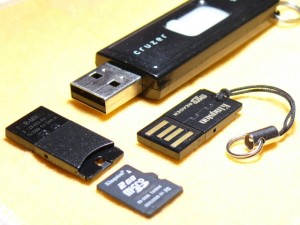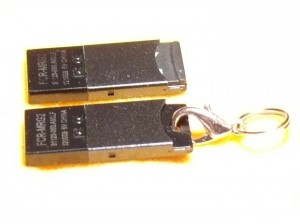Archive for October 17, 2012
Kingston: too scared to engage
0A while back, I ordered a couple of microSD cards from Kingston. They came with these nifty little USB card readers.
Here is a picture.
The microSD card is in the front, and there are two of the USB card readers right behind it (one is upside-down). In the back, for comparison of scale, I show a Sandisk Cruzer Micro USB stick.
These tiny little USB card readers are very nice, attractive, and very well built. You can see that the USB plug only has the inner part with the four contacts. They left off the rectangular metal shell that most USB plugs have.
The reader can be fastened to your key ring using the little nylon string that is tied into a small hole in the end. They have gone so far as to make the hole a little bit recessed, so you can still plug in the microSD card while the string is attached.
Overall, it is a beautiful design.
However, I am not a fan of the little nylon strings. I was hoping that I could use a metal fastener to attach this reader to my key chain. A metal fastener would not jiggle around or get tangled like the string would. And it would also keep the microSD card from dropping out and getting lost.
So I wrote a short note to the folks at Kingston.
Hi guys,
I am currently in the process of moving from SD cards to micro SD cards, and I just bought a few from Kingston. These came with some nice micro SD card readers (see the photo attached).
I have an idea that might make these readers better for some of your customers (and for those who do not need the change, it would be no worse than what you have now).
Your current design is just long enough so that an inserted micro SD card is flush with the back edge. You can tell that someone took some great care to design the slot where the little string goes, because it still fits when a card is inserted, and it provides a little bit of pressure against the card, to keep it from falling out.
However, if the micro SD card reader were about 1.5 mm longer, the string hole would stick out past the end of an inserted micro SD card. That is, a card could be plugged in, and you could still see through the hole. This would make it possible to use other connectors besides the little strings. Personally, I like to use small split ring keyrings. Or like I have pictured here, you could use a crab claw clasp.
The little strings are a hassle on a keyring, especially since they are holding something so light in weight. The strings sometimes get tangled up in my keys. And the string does not really ensure that the card won’t slip out… it helps by adding some friction, but it does not BLOCK the card from coming out.
It’s something to consider. I hope you will. Your little reader looks to be the tiniest and most “robust” looking of the micro card readers out there. I think this little improvement would put it way over the top as the best reader to have.
Thanks, and all the best.
Alan Porter
I was very surprised when I received a reply from Kingston.
Dear Alan,
Thank you for your interest in Kingston Technology. Also, thank you for your input and suggestion for Kingston’s product line.
Kingston greatly values our customers’ opinions and insight. Unfortunately due to today’s litigious society, Kingston is forced to discard suggestions pertaining to new and future products. Therefore, we will be unable to move forward with your input and/or suggestion. We hope you understand our position.
If you have any other questions or require further assistance, feel free to contact us directly at 800 xxx-xxxx. We are available M-F, 6am-5pm, PT. I hope this information is helpful. Thank you for selecting Kingston as your upgrade partner.
Please include your email history with your reply
Best Regards,
xxxxxx xxxxxx
Customer Service/Sales Support
Kingston Technology Company
What a nice gesture… a personal thank-you note.
But what’s this part all about??
Unfortunately due to today’s litigious society, Kingston is forced to discard suggestions pertaining to new and future products.
I was shocked. They thanked me for writing, but they simply won’t allow themselves to listen to their biggest fans, because they’re scared that someone might sue them for listening.
What a horrible statement about our society! This is the exact polar opposite of the principles of sharing and feedback and continuous improvement that I am used to dealing with in the open source community.
Kingston lives in a feedback-free vacuum, fingers in their ears, and they blame us all for their uncooperative attitude. What does this say about us? Has the greatest nation in the world slowly grown old and senile, becoming scared of its own shadow? Will my children grow up to be scared to talk to strangers, scared to have a genuine dialog with another human, scared to actually accept criticism and suggestions, scared that someone would sue them, scared that they might tarnish their sacred brand? Is this the world that I want to leave to my children? Hell, no. So I made sure to write back to Kingston and register my disapproval of their spineless policy.
I hope some Chinese company will run with the elongation improvement. They don’t seem to be crippled by the imaginary legal threats from their own customers like Kingston seems to be.
I should note:
- I still like Kingston and their products. But this extreme risk aversion is the wrong way to go.
- My “improvement” has now been published (here on this blog), and so it is now officially “prior art” and can not be patented. That means that companies — Kingston included — are free to use this idea without fear of being hit up on charges of patent infringement.
- The newer business tactic is to actively engage customers, creating a dialog with them, and letting them feel like they are contributing; not to blow them off and blame it on society.
Personally, I hope we will begin to see less of this corporate (and personal) scaredy cat culture in America.

